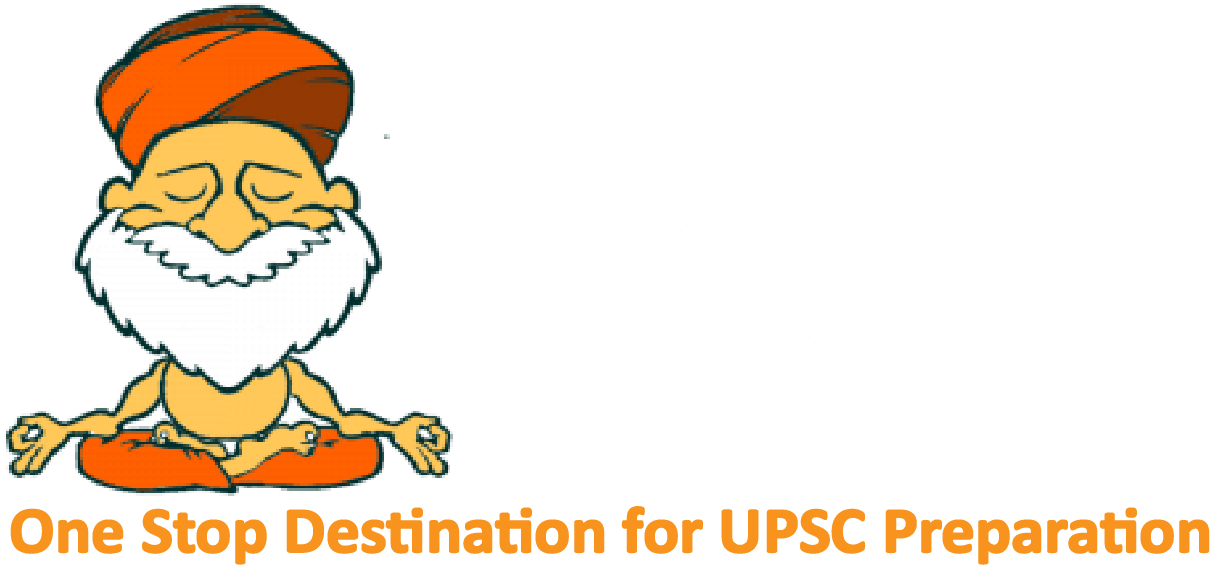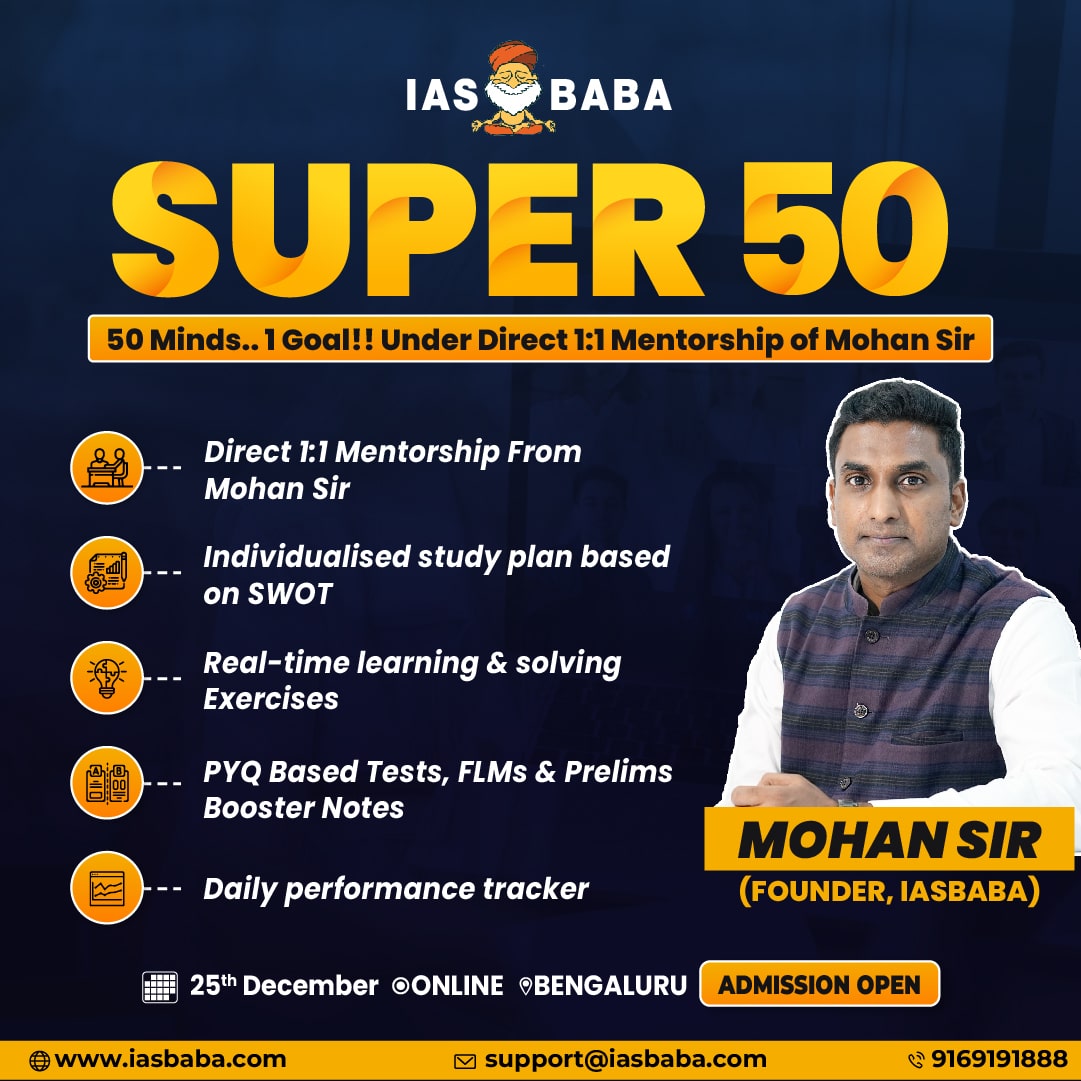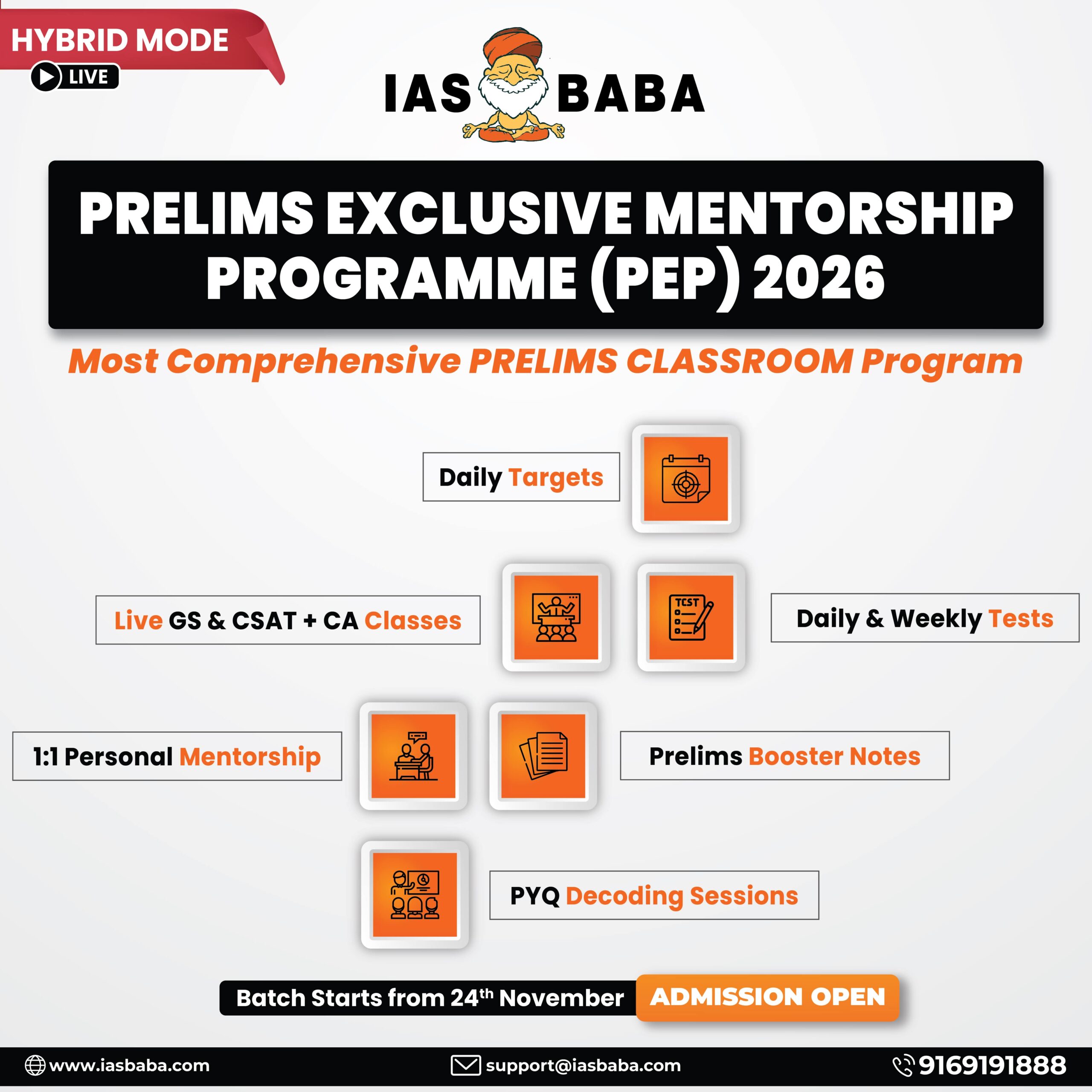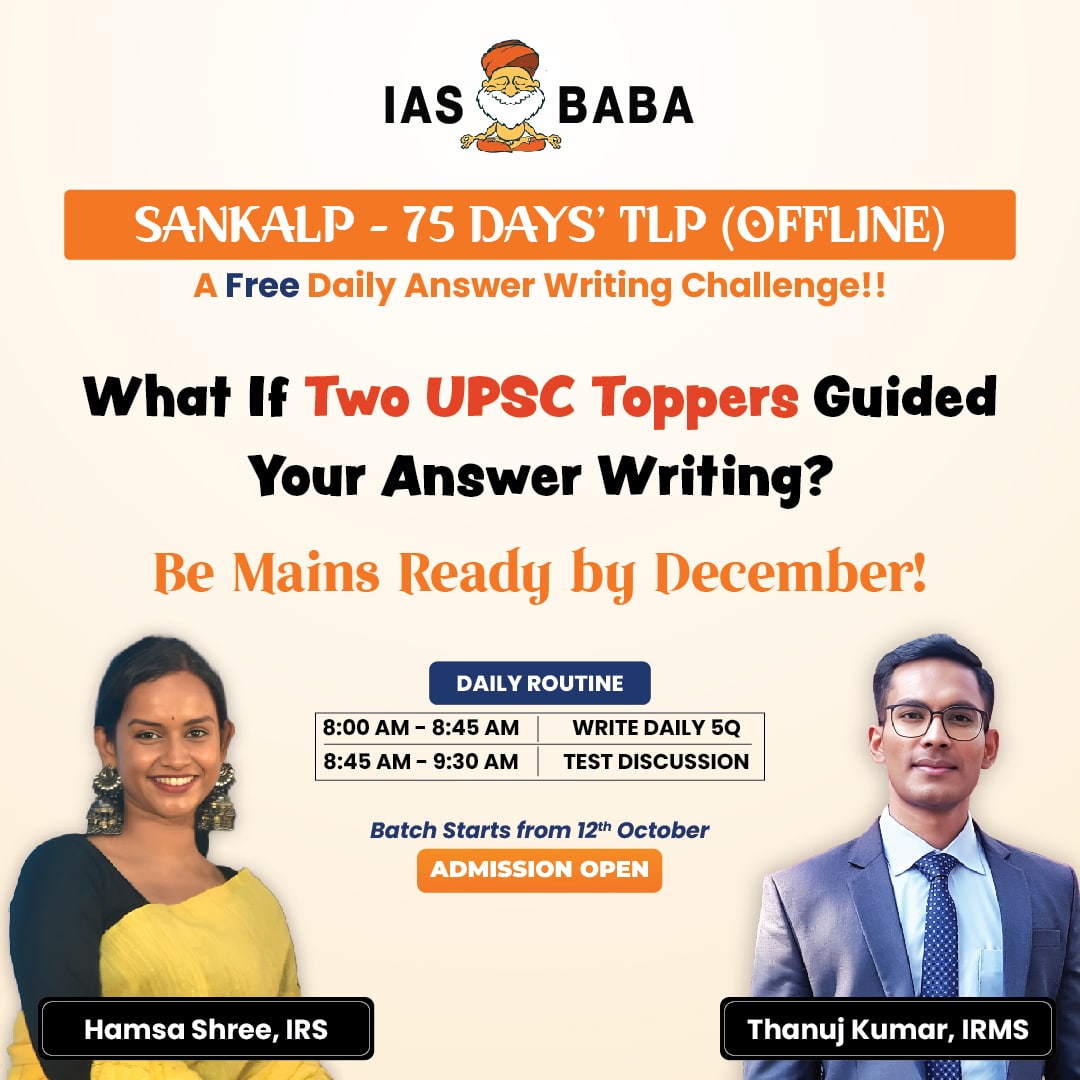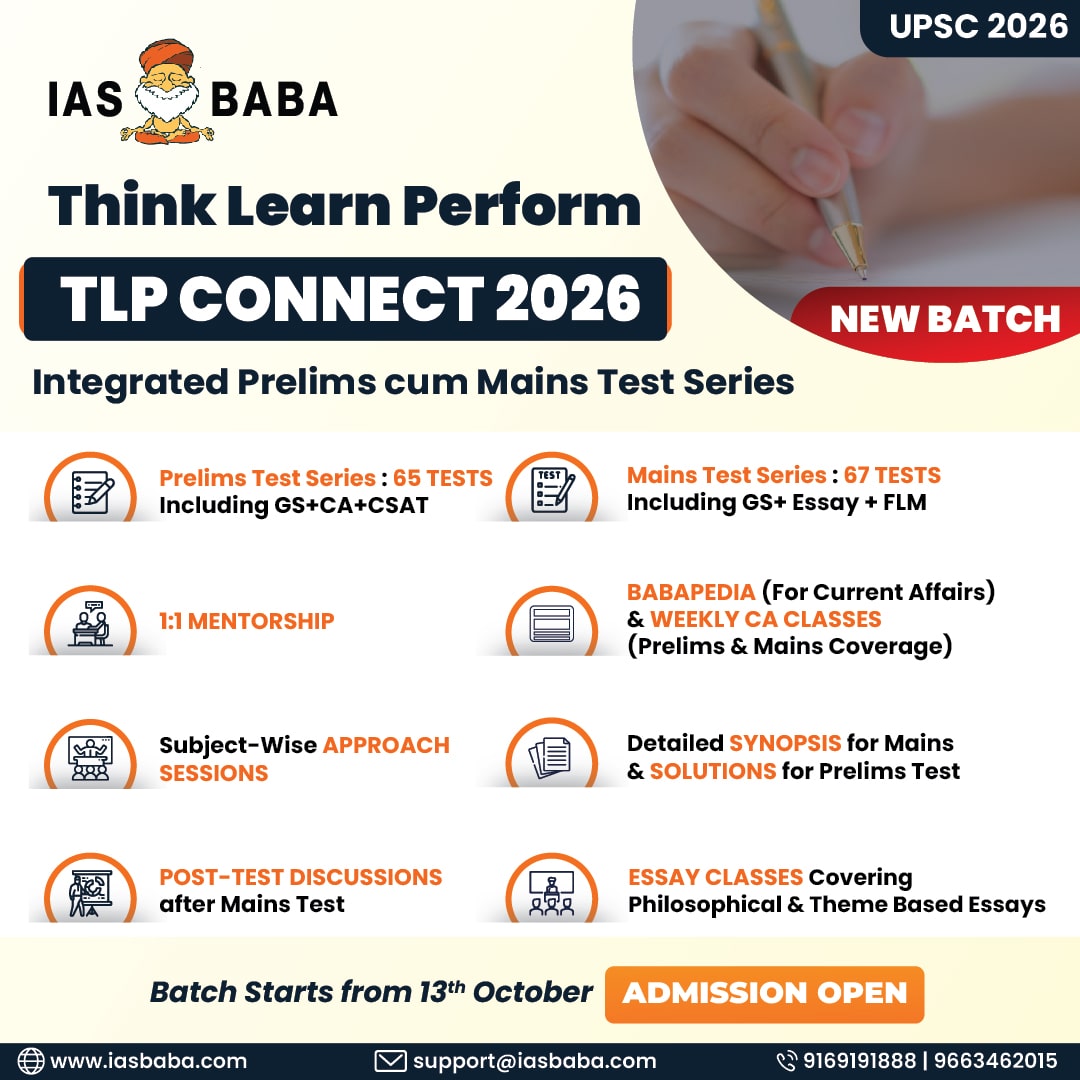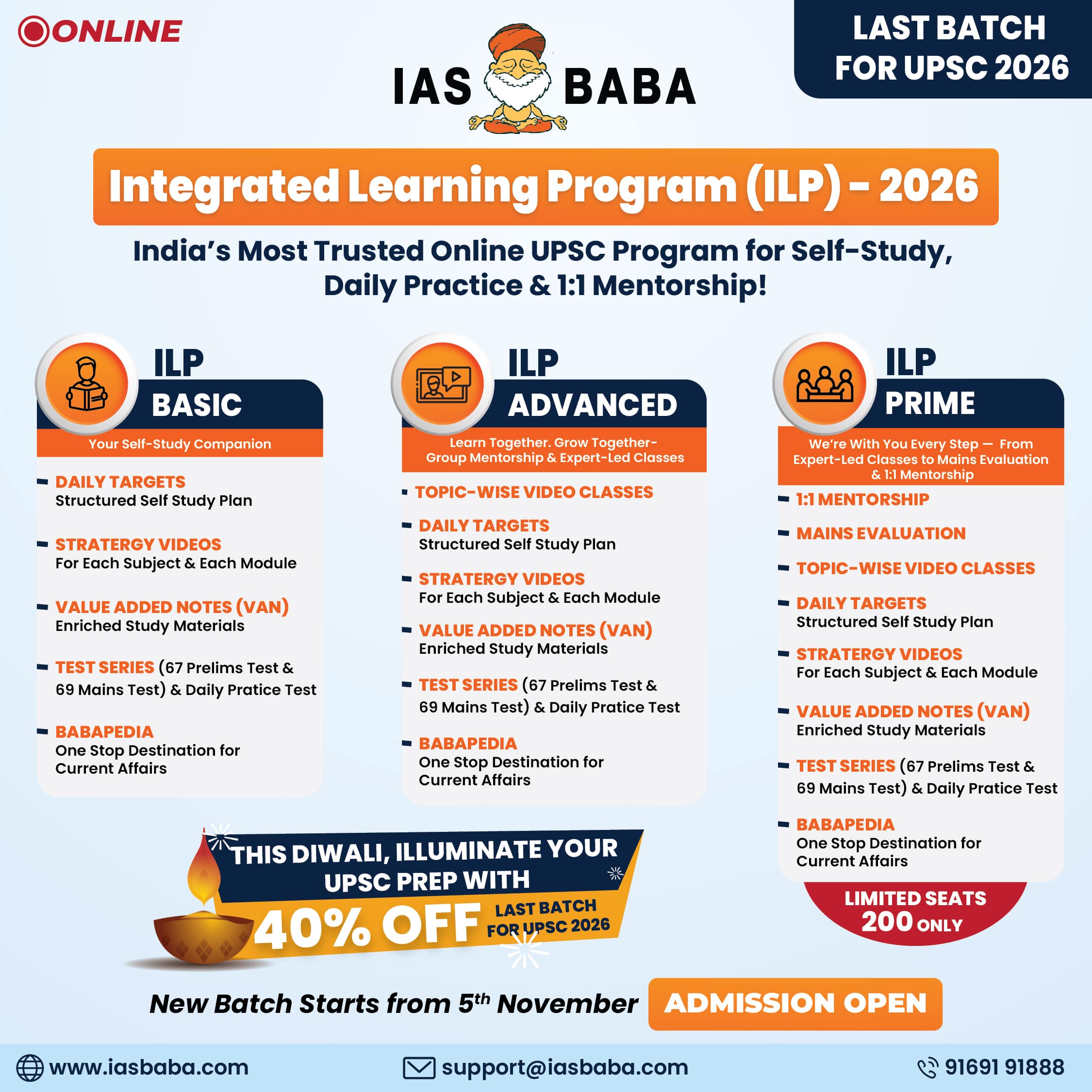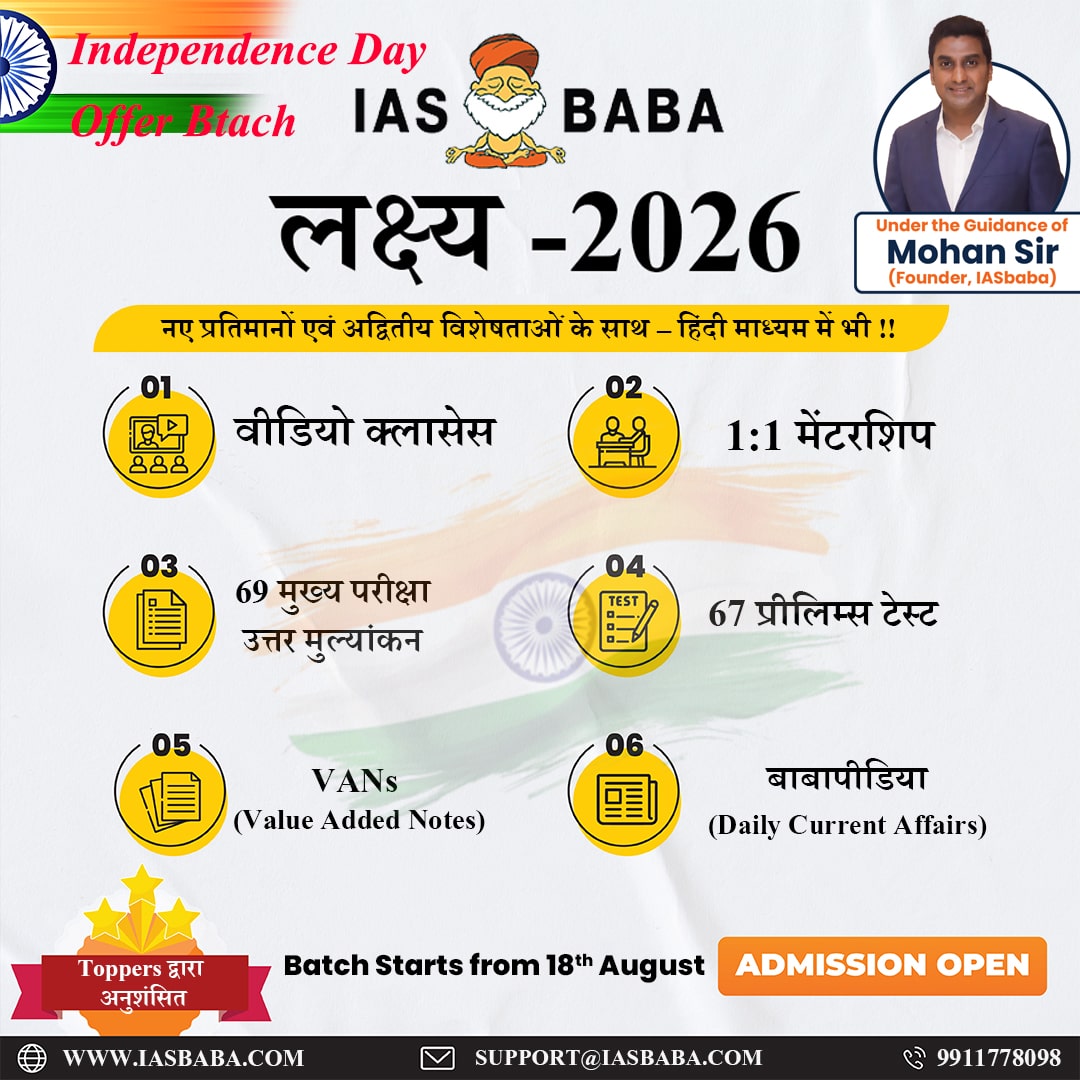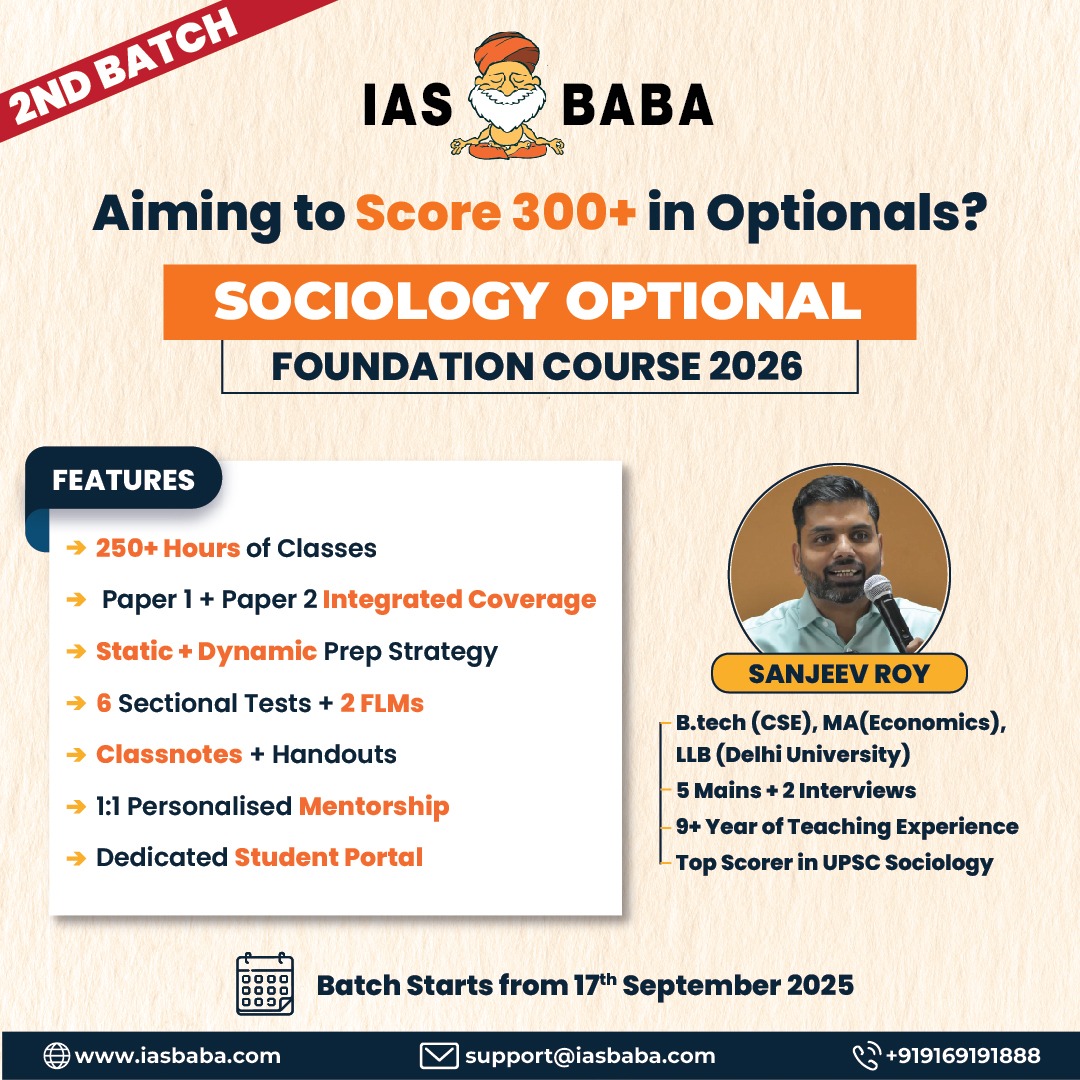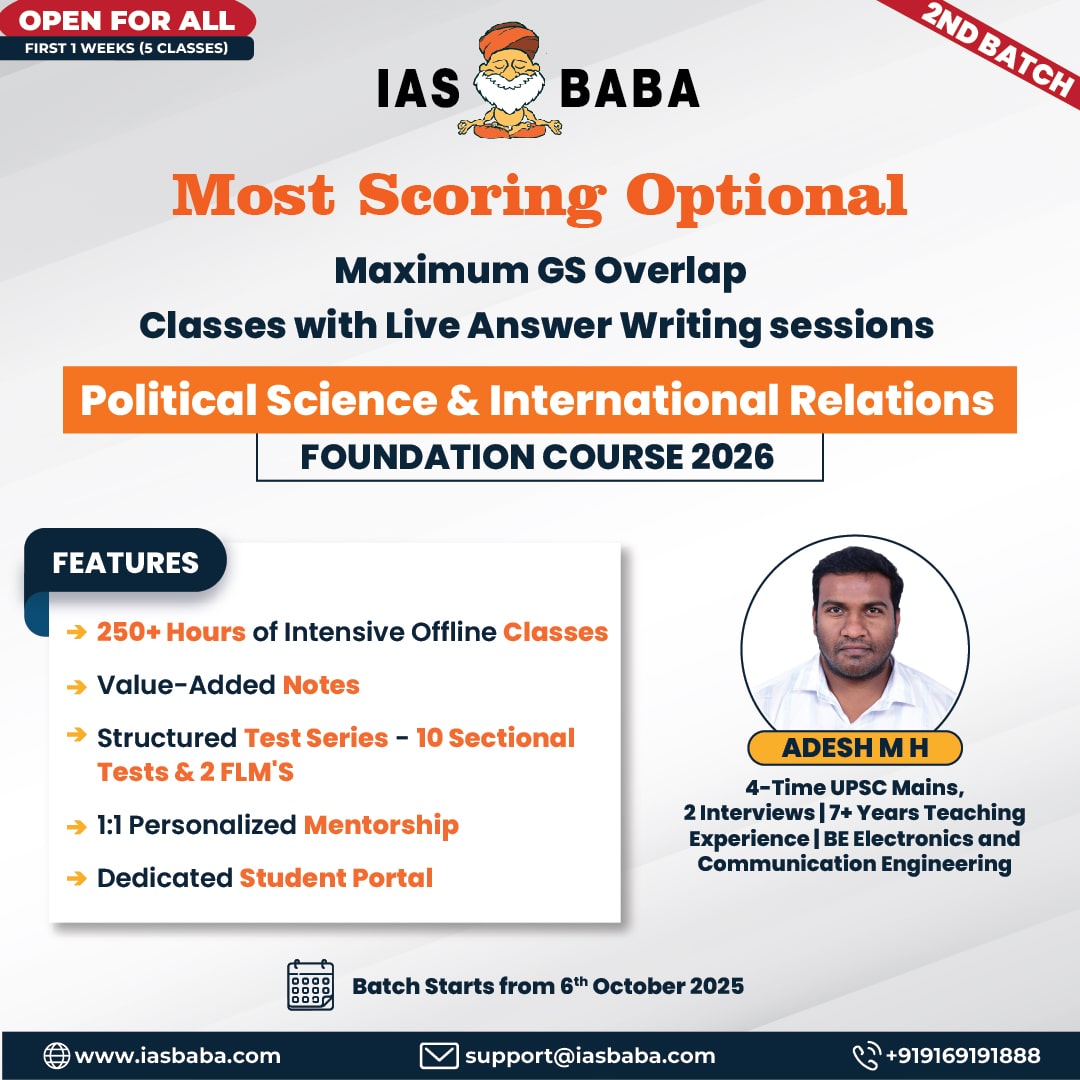IASbaba Daily Prelims Quiz
For Previous Daily Quiz (ARCHIVES) – CLICK HERE
The Current Affairs questions are based on sources like ‘The Hindu’, ‘Indian Express’ and ‘PIB’, which are very important sources for UPSC Prelims Exam. The questions are focused on both the concepts and facts. The topics covered here are generally different from what is being covered under ‘Daily Current Affairs/Daily News Analysis (DNA) and Daily Static Quiz’ to avoid duplication. The questions would be published from Monday to Saturday before 2 PM. One should not spend more than 10 minutes on this initiative.
Gear up and Make the Best Use of this initiative.
Do remember that, “the difference between Ordinary and EXTRA-Ordinary is PRACTICE!!”
Important Note:
- Don’t forget to post your marks in the comment section. Also, let us know if you enjoyed today’s test 🙂
- After completing the 5 questions, click on ‘View Questions’ to check your score, time taken, and solutions.
Test-summary
0 of 5 questions completed
Questions:
- 1
- 2
- 3
- 4
- 5
Information
To view Solutions, follow these instructions:
- Click on – ‘Start Test’ button
- Solve Questions
- Click on ‘Test Summary’ button
- Click on ‘Finish Test’ button
- Now click on ‘View Questions’ button – here you will see solutions and links.
You have already completed the test before. Hence you can not start it again.
Test is loading...
You must sign in or sign up to start the test.
You have to finish following test, to start this test:
Results
0 of 5 questions answered correctly
Your time:
Time has elapsed
You have scored 0 points out of 0 points, (0)
| Average score |
|
| Your score |
|
Categories
- Not categorized 0%
| Pos. | Name | Entered on | Points | Result |
|---|---|---|---|---|
| Table is loading | ||||
| No data available | ||||
- 1
- 2
- 3
- 4
- 5
- Answered
- Review
-
Question 1 of 5
1. Question
Consider the following statements about the SAARC Visa Exemption Scheme (SVES)
The SAARC Visa Exemption Scheme was launched in 1992 with the primary objective of promoting people-to-people contact within the South Asian region.
Under the SVES, only prominent businessmen and senior government officials of SAARC member states are eligible for visa-free travel.
The SVES cardholders are entitled to stay in the host country for a period not exceeding three months on each visit.How many of the statements given above are correct?
Correct
Solution (b)
Statement Analysis
Statement 1 Statement 2 Statement 3 correct Incorrect correct - The SAARC Visa Exemption Scheme (SVES) was indeed launched in 1992. Its main aim is to facilitate easier travel and promote greater people-to-people contact and understanding among the citizens of SAARC member states.
- While prominent businessmen and senior government officials are included in the categories of individuals eligible for the SVES, the scheme also extends to several other categories such as parliamentarians, judges of the Supreme Court, academics, journalists, and students.
- Generally, the SAARC Visa Exemption Scheme cardholders are granted a single entry visa with a permitted stay of up to three months in the host country
Context:The Indian government has announced that Pakistan nationals will not be permitted to travel to India under the SAARC Visa Exemption Scheme (SVES).
Incorrect
Solution (b)
Statement Analysis
Statement 1 Statement 2 Statement 3 correct Incorrect correct - The SAARC Visa Exemption Scheme (SVES) was indeed launched in 1992. Its main aim is to facilitate easier travel and promote greater people-to-people contact and understanding among the citizens of SAARC member states.
- While prominent businessmen and senior government officials are included in the categories of individuals eligible for the SVES, the scheme also extends to several other categories such as parliamentarians, judges of the Supreme Court, academics, journalists, and students.
- Generally, the SAARC Visa Exemption Scheme cardholders are granted a single entry visa with a permitted stay of up to three months in the host country
Context:The Indian government has announced that Pakistan nationals will not be permitted to travel to India under the SAARC Visa Exemption Scheme (SVES).
-
Question 2 of 5
2. Question
Consider the following statements about the Section 19 of POCSO
- Section 19 mandates that any person who has apprehension that an act of sexual assault, sexual harassment, or aggravated sexual assault has been committed against a child must report it to the Special Juvenile Police Unit or the Local Police.
- Failure to report an offense under Section 19 is a non-cognizable and bailable offense punishable with a fine.
- The reporting obligation under Section 19 extends to all individuals, including parents and guardians of the child.
How many of the statements given above are correct?
Correct
Solution (b)
Statement Analysis
Statement 1 Statement 2 Statement 3 correct Incorrect Correct - Section 19 of the POCSO Act, 2012 places a mandatory reporting obligation on any person who has knowledge or reasonable apprehension that an offense under the Act has been committed against a child.
- Failure to report an offense under Section 19 is a cognizable and non-bailable offense, punishable with imprisonment which may extend to six months or with fine or with both.
- The reporting obligation under Section 19 is broad and applies to all individuals, including parents, guardians, relatives, neighbors, teachers, and any person who has the requisite knowledge or apprehension.
Context:The Supreme Court will examine concerns raised by Indira Jaising that mandatory reporting under Section 19 of POCSO is criminalising consensual adolescent sexual activity and threatening girls’ right to health.
Incorrect
Solution (b)
Statement Analysis
Statement 1 Statement 2 Statement 3 correct Incorrect Correct - Section 19 of the POCSO Act, 2012 places a mandatory reporting obligation on any person who has knowledge or reasonable apprehension that an offense under the Act has been committed against a child.
- Failure to report an offense under Section 19 is a cognizable and non-bailable offense, punishable with imprisonment which may extend to six months or with fine or with both.
- The reporting obligation under Section 19 is broad and applies to all individuals, including parents, guardians, relatives, neighbors, teachers, and any person who has the requisite knowledge or apprehension.
Context:The Supreme Court will examine concerns raised by Indira Jaising that mandatory reporting under Section 19 of POCSO is criminalising consensual adolescent sexual activity and threatening girls’ right to health.
-
Question 3 of 5
3. Question
Which of the following statements is correct regarding Tax Collected at Source (TCS) under the Income Tax Act, 1961?
Correct
Option c It is a mechanism where the seller of certain goods is required to collect tax from the buyer at the time of sale and deposit it with the government. Context:Luxury goods priced above ₹10 lakh, such as handbags, watches, and sportswear are now subject to a 1% Tax Collected at Source (TCS) .
Incorrect
Option c It is a mechanism where the seller of certain goods is required to collect tax from the buyer at the time of sale and deposit it with the government. Context:Luxury goods priced above ₹10 lakh, such as handbags, watches, and sportswear are now subject to a 1% Tax Collected at Source (TCS) .
-
Question 4 of 5
4. Question
Consider the following statements about the Chlorpyrifos Pesticide
- Chlorpyrifos is an organophosphate insecticide widely used in agriculture to control a variety of pests in crops and animals.
- The use of Chlorpyrifos has been globally encouraged by international health organizations due to its low persistence in the environment and minimal impact on non-target organisms.
Choose the incorrect statements:
Correct
Solution (b)
Statement Analysis
Statement 1 Statement 2 correct Incorrect - Chlorpyrifos is indeed an organophosphate insecticide that has been extensively used in agriculture to control a broad range of pests affecting various crops, as well as for animal pest control.
- Contrary to being globally encouraged, the use of Chlorpyrifos has been facing increasing scrutiny and restrictions or bans in many countries due to concerns about its potential harm to human health and the environment.
Context:Indian experts have called for an immediate ban on chlorpyrifos, a toxic pesticide.
Incorrect
Solution (b)
Statement Analysis
Statement 1 Statement 2 correct Incorrect - Chlorpyrifos is indeed an organophosphate insecticide that has been extensively used in agriculture to control a broad range of pests affecting various crops, as well as for animal pest control.
- Contrary to being globally encouraged, the use of Chlorpyrifos has been facing increasing scrutiny and restrictions or bans in many countries due to concerns about its potential harm to human health and the environment.
Context:Indian experts have called for an immediate ban on chlorpyrifos, a toxic pesticide.
-
Question 5 of 5
5. Question
Consider the following statements about the Palmyra
- Palmyra was a major trading hub situated along the Silk Road, connecting the Roman Empire with Persia and the East.
- The city flourished particularly during the reign of Queen Zenobia in the 3rd century AD, who famously challenged Roman authority.
Choose the correct statements:
Correct
Solution (c)
Statement Analysis
Statement 1 Statement 2 correct correct - Palmyra’s strategic location in the Syrian Desert made it a crucial caravan oasis and a vital trading center along the Silk Road. It facilitated the exchange of goods between the Roman Empire, Persia, India, and China, leading to its significant wealth and prosperity.
- Queen Zenobia ruled the Palmyrene Empire in the 3rd century AD after the death of her husband Odaenathus. She expanded her influence and famously revolted against Roman authority, briefly establishing an independent empire that stretched across parts of the Roman East before being ultimately defeated by Emperor Aurelian.
Context:The Syrian civil war in 2011, turned Palmyra’s strategic location into a conflict zone, leading to widespread destruction of its ancient monuments.
Incorrect
Solution (c)
Statement Analysis
Statement 1 Statement 2 correct correct - Palmyra’s strategic location in the Syrian Desert made it a crucial caravan oasis and a vital trading center along the Silk Road. It facilitated the exchange of goods between the Roman Empire, Persia, India, and China, leading to its significant wealth and prosperity.
- Queen Zenobia ruled the Palmyrene Empire in the 3rd century AD after the death of her husband Odaenathus. She expanded her influence and famously revolted against Roman authority, briefly establishing an independent empire that stretched across parts of the Roman East before being ultimately defeated by Emperor Aurelian.
Context:The Syrian civil war in 2011, turned Palmyra’s strategic location into a conflict zone, leading to widespread destruction of its ancient monuments.
- Current Affairs Quiz, IAS Daily Current Affairs Quiz, IAS UPSC Current Affairs Quiz, IAS UPSC Prelims Quiz, IASbaba's Current Affairs Prelims Quiz, IASbaba's Daily Quiz, IASbaba's UPSC Quiz, Prelims Current Affairs Quiz, UPSC Current Affairs Quiz, UPSC Current Affairs Quiz IASbaba, UPSC Daily Current Affair Quiz, UPSC IAS Daily Quiz

